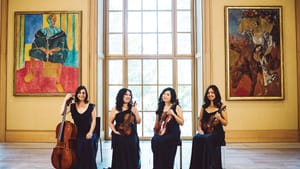Stay in the Loop
BSR publishes on a weekly schedule, with an email newsletter every Wednesday and Thursday morning. There’s no paywall, and subscribing is always free.
Two quintets with Haydn in the middle
The Philadelphia Chamber Music Society with the Aizuri Quartet and Ignat Solzhenitsyn

The Philadelphia Chamber Music Society brought its season to a close with the Aizuri Quartet making its debut in the series with a pair of Russian piano quintets, one well-known and one obscure. Ignat Solzhenitsyn, a familiar face at these concerts, joined them for the performances, with a mid-period Haydn quartet in between.
The novelty of the program was Anatoly Drozdov’s 1920 Quintet. Drozdov (1883-1950), a pianist whose compositions heavily feature his instrument, was a close contemporary of Nikolai Myaskovsky, who’s not exactly a household name either, although his 10th Symphony was performed at this year’s Philadelphia Orchestra concerts.
Both men, along with the elder statesman Alexander Glazunov, helped keep the flame of Russian music alive in the difficult days after the 1917 Revolution, when its chief luminaries—Rachmaninoff, Stravinsky, and Prokofiev—either emigrated or remained abroad (Prokofiev returned to stay after 1933, lured by homesickness rather than Bolshevism).
Like his mentor Alexander Scriabin, Drozdov experimented with a musical chromaticism that pushed the bounds of tonality without ever quite abandoning them. His Piano Quintet, a 25-minute work in one movement, is among his more substantial compositions. By turns brooding, dreamy, and agitated, it is unlikely to achieve repertory status, but it is a serious work and proved well worth hearing. The Aizuri players, who have been in residence at the Curtis institute, seemed at times a little out of their league with the formidable Solzhenitsyn, but cellist Karen Ouzounian stood out as a strong performer.
Between Shostakovich and Stravinsky
Haydn’s Quartet, Op. 33, No. 1, is in a key, B minor, not only unusual for him but, as Misha Amory pointed out in his program notes, for the quartet literature in general. I can think offhand of only one other prominent example, Prokofiev’s First Quartet, which is a very different work. The Haydn is a mercurial piece, with a touch of the Sturm und Drang volatility characteristic of his mid-period symphonies, although with little of their gravity. It’s a salutary and thoroughly entertaining reminder of how emotionally complex and unpredictable Haydn can be, and how much restless invention the classical style can accommodate. The Aizuri fared better here, with dexterous exchanges, if not a fully robust tone.
Classicism made a strong comeback in the 20th century through Igor Stravinsky who, after pushing post-Romantic primitivism to its limits in the Rite of Spring, found in it a dramatic break with Wagnerian afflatus. Shostakovich, as we know now, revered Stravinsky, but his own Romanticism would seem very far from classical models. There was a brief but significant period, however, in which classicism did find its way into his music, in the immediate prewar years of 1938-1940, that saw the composition of his First Quartet, his Sixth Symphony, and, most popularly, the Piano Quintet in G minor, which was awarded the then-staggering sum of 100,000 rubles together with the Stalin Prize by Soviet authorities, and remains perhaps the most popular composition of the 20th century for its ensemble.
A fine finale
The work begins with declamatory passages for the piano alone, played with characteristic authority by Mr. Solzhenitsyn and leading to a slowly-unfolding fugue in the strings. The clarity and occasional astringency of the writing steers the music clear of any portentousness. The interweaving of piano with the body of the strings shows a masterful thinking-out of the sonic possibilities and relationships of the quintet form in modern terms.
The restrained yet impassioned climax of the slow movement sounds the darkest emotional note of the work. It returns in the Presto finale as a reminder of the music’s deeper business, but, deftly switching gears — a trick at which Shostakovich was as adept as Haydn — it comes to a close on a rare note of serenity, and even with a wink. There were fine touches in the performance, including a lovely handoff between Miho Saegusa’s first violin and Ayane Kozasa’s viola.
The PCMS series has won a devoted audience, and deservedly so. This final house, a full one, went away with evident satisfaction. Now the dry season begins in Philadelphia, at least for classical music. There must be a reason for it, but for now, the rest will pretty much be silence.
What, When, Where
Philadelphia Chamber Music Society. Anatoly Drozdov, Piano Quintet in A Minor, Op. 11. Franz Joseph Haydn, String Quartet in B Minor. Op. 33, No. 1. Dimitri Shostakovich, Piano Quintet in G Minor, Op. 57. The Aizuri Quartet. Ignat Solzhenitsyn, piano. May 18, 2016, at the American Philosophical Society, 427 Chestnut Street. (215) 569-8080 or pcmsconcerts.org.
Sign up for our newsletter
All of the week's new articles, all in one place. Sign up for the free weekly BSR newsletters, and don't miss a conversation.
 Robert Zaller
Robert Zaller